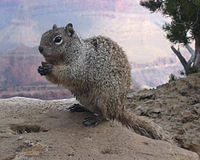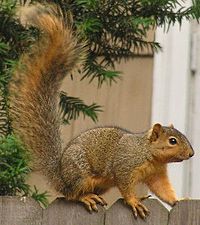User:SylviTin21/sandbox
| Japanese dwarf flying squirrel | |
|---|---|

| |
| Scientific classification | |
| Kingdom: | |
| Phylum: | |
| Class: | |
| Order: | |
| Family: | |
| Tribe: | |
| Genus: | |
| Species: | P. momonga
|
| Binomial name | |
| Pteromys momonga Temminck, 1844
| |
The Japanese dwarf flying squirrel (Pteromys momonga; Japanese: ニホンモモンガ; Hepburn: Nihon momonga) is one of two species of Old World flying squirrels.
Morphology[edit]
Its body is 14–20 cm long and the tail length is 10–14 cm. It weighs 150–220 g. It is much smaller than the Japanese giant flying squirrel which can reach 1500 g. Its back is covered with grey brown hair, and its belly is white. It has large eyes and a flattened tail. Species of flying squirrels possess a patagium, which is a skin membrane used in gliding. In this particular species of flying squirrel their patagium spans between their wrists and ankles, but not between their legs and tail. [2]
Distribution[edit]
Range[edit]
This species of flying squirrel inhabits sub-alpine forests and boreal evergreen forests in Japan,specifically on Honshu and Kyushu islands. [3]
Habitat[edit]
Japanese dwarf flying squirrels make their nests in the cavities of trees,or at the cross point between branches and tree trunks. These squrrels also tend to line their nests with mosses and lichens. [4] Tree cavities are very important nest resources for them. They tend to nest in conifers, such as pine and spruce, more than broad-leaved trees.[5]
Behavior[edit]
Feeding Behaviors[edit]
The Japanese Dwarf Flying Squirrel is nocturnal, and during the day it rests in holes in trees. It eats seeds, fruit, tree leaves, buds and bark. It can leap from tree to tree using a gliding membrane called its patagium. The patagium works as a wingsuit enabling it to maneuver and glide through the air.[6]
When it feeds, the Japanese dwarf flying squirrel assumes a hanging posture. It will pull a twig to its mouth with its forepaws if the twig is not strong enough to support its weight and obtain food at the tip. While picking up food scattered on the ground, it will extend its body in an intermediate range around its body without moving its hind legs.[7]
Social Behavior[edit]
Multiple individuals of this species can be found grouped together on a single tree, however usually these individuals tend to be of the same sex when it is not mating season. Mating nests are usually shared by one breeding pair. [4]
Reproductive Behaviors[edit]
Not much is known about the specific mating rituals of these squirrels. The squirrels tend to mate twice a year between the months of May and July, with a gestation period of around 4 weeks. Litter size average about 2 to 3 young, but can have up to 5 pups. They are thought to develop similarly to that of other flying squirrels, and are weaned by around 6 weeks of age. [4]
Evolution[edit]
Japanese dwarf flying squirrels have evolved differently from other sciuridae. The differences between Japanese dwarf flying squirrels and other sciuridae is evident when comparing morphology of the mandible and genetic code. The mandible of the Japanese dwarf flying squirrel does not have a coronoid process unlike the dwarf tree squirrel. The marmota also has a more elongated mandible than the Japanese dwarf flying squirrel. This is due to phylogeny and ecology.[8] There are also large differences in chromosome structure between P. momonga and the only other member of the the Pteromys genus, Pteromys volans. Though they have the same number of chromosomes (2n=38), their karyotypes differ extensively due to pericentric inversions, tandem fusions, and deletion of large segments of the autosomes and the Y chromosome. Because of these deletions, the P. volans genome contains about fifteen percent less DNA than P. momonga. These findings suggest that the karyotype of P. momonga more closely resembles the ancestor of P. volans and P. momonga.[9]
Conservation Status[edit]
The IUCN has this species of Flying Squirrel listed as of least concern.
References[edit]
- ^ "Pteromys momonga". IUCN Red List of Threatened Species. 2008. 2008.
{{cite journal}}: Unknown parameter|assessors=ignored (help); Unknown parameter|downloaded=ignored (help) - ^ Watkins, Tracy. "Pteromys Momonga". Animal Diversity Web. Retrieved 28 November 2014.
- ^ Nowak, Ronald M. (1999). Walker's mammals of the world / : Ronald M. Nowak (6th ed. ed.). Baltimore, Md.: Johns Hopkins University Press. p. 1297. ISBN 0-8018-5789-9.
{{cite book}}:|edition=has extra text (help) - ^ a b c Nowak, Ronald M. (1999). Walker's mammals of the world / : Ronald M. Nowak (6th ed. ed.). Baltimore, Md.: Johns Hopkins University Press. p. 1297. ISBN 0-8018-5789-9.
{{cite book}}:|edition=has extra text (help) - ^ Suzuki, K., Shimamoto, T., Takizawa, Y., Kamigaichi, H., Ando, M., & Yanagawa, H. (2011). Nest site characteristics of pteromys momonga in the tanzawa mountains. Honyurui Kagaku/Mammalian Science, 51(1), 65-69. Retrieved from http://search.proquest.com/docview/907186500?accountid=26746
- ^ Stafford, B. J., Thorington Jr., R. W., & Kawamichi, T. (2002). Gliding Behavior Of Japanese Giant Flying Squirrels (Petaurista Leucogenys). Journal of Mammalogy, 83(2), 553-562.
- ^ Ando, M., Shiraishi, S., & Uchida, T. A. (1985). Feeding behaviour of three species of squirrels. Behaviour, 95(1-2), 76-86. Retrieved from http://search.proquest.com/docview/14485007?accountid=26746
- ^ Michaux, J., Hautier, L., Simonin, T., & VianeyLiaud, M. (2008). Phylogeny, adaptation and mandible shape in Sciuridae (Rodentia, Mammalia). Mammalia: Journal De Morphologie, Biologie, Systematique Des Mammiferes, 72(4), 286-296.
- ^ Oshida, T., Yanagawa, H., Tsuda, M., Inoue, S., & Yoshida, M. C. (2000). Comparisons of the banded karyotypes between the small japanese flying squirrel, pteromys momonga and the russian flying squirrel, P. volans (rodentia, sciuridae). Caryologia, 53(2), 133-140. Retrieved from www.scopus.com





